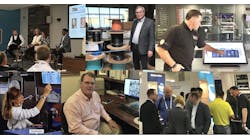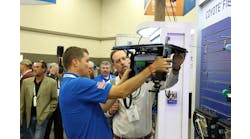Latest from Professional Development/Training
How Many More Techs Do We Really Need?
Everybody, including me, has been talking about the workforce shortage in fiber optics. A couple years ago, a major service provider said it needed 850,000 more telecom techs. Someone mentioned in a recent meeting with government officials at the White House that America needs another 200,000 fiber techs to complete the broadband projects that will be funded by the BEAD program.
Do those numbers make sense? Or is it just wild speculation? Understanding the need for more fiber optic techs requires understanding how many there are now and how fast the work to be done is growing.
“... if the current workforce can connect 8 million users in a year at the same time they are building hundreds of new data centers, long lengths of OSP networks, fiber networks supporting 5G cellular systems, municipal systems, etc., do we need to double or triple the number of available fiber techs in the workforce?”
Since the industry has been focused on BEAD projects, it also requires knowing just how much work is involved in the broadband networks that will be funded by BEAD. Let’s start there.
If you analyze the BEAD data from NTIA, they give the dollar amount available to every state based on their analysis of the percentage of users in each state that were unserved or underserved. At FOA, we analyzed the NTIA data using the latest census numbers and discovered that the number of households included in the NTIA estimates was only approximately 10.3 million households out of the total of 128 million households in the U.S. (Download our spreadsheet HERE.)
It was reported by a trade association recently that last year was a banner year for FTTH in America with almost 8 million new subscribers connected on fiber. That's a pretty big number.
So, if the current workforce can connect 8 million users in a year at the same time they are building hundreds of new data centers, long lengths of OSP networks, fiber networks supporting 5G cellular systems, municipal systems, etc., do we need to double or triple the number of available fiber techs in the workforce?
Also, consider that the BEAD money is going to take five years or more to be spent on actual projects. That means we're looking at a ~25-30% increase in FTTH connections each year, not a doubling or tripling of current work like some people are saying.
We do have a problem of workers retiring and needing replacements; that is true for all the trades. I’ve read estimates that the number of young people entering some of the trades is less than 20%, as many as are retiring, and that’s a problem. That’s why FOA is trying to get more technical high schools and colleges to teach telecom programs—we need more young people joining our fiber and telecom workforce.
But 200,000 or 850,000 new techs right now? Does that make sense? Or is it just more hype, perhaps hoping to take advantage of the training money set aside in the federal funding for broadband?
Part of the problem is that until recently we didn’t really know much about the fiber optic workforce or the overall telecom workforce. The statistics for these jobs have been buried in the U.S. Department of Labor’s outdated definitions of the jobs.
The FOA has been working with the U.S. Department of Labor’s Bureau of Labor Statistics (BLS) for about 20 years to define the jobs of fiber optic technicians. When first added by the BLS, fiber optic techs were placed in a category of "electrical linemen," a long-time category of other workers who install cables.
This year, in part due to the federal focus on broadband, a BLS analyst told us there was interest in creating a new category. We worked with them for months helping draft new job descriptions, brought in some contacts from the Communications Workers of America (CWA), and suggested adding wireless techs (who were also buried elsewhere in the BLS) to help create a new category for "Telecommunications Technicians."
It all came together nicely. The website is live now. The site offers better job statistics that help put some reality in discussions about how many more fiber techs the U.S. really needs. It also provides a reference for grants applications for those state broadband agencies that are seeking funding for workforce development. (Link to BLS page.)
What does the BLS say about the telecom business? They conclude that there are about 300,000 workers in telecom-related jobs in the U.S.; about 112,000 of them are cable installers. Yep, they even include the copper techs with the fiber techs. They also note that median pay is about $60,000. Both those numbers seem about right to FOA, and we congratulate BLS for doing a commendable job on this work.
What can we conclude from this BLS analysis? To begin with, the estimates of the U.S. needing 850,000 or even 200,000 more telecom or fiber techs is greatly exaggerated. For the BEAD program, we might need another 10,000-20,000 techs over the next few years, not much more than FOA-affiliated schools are doing anyway, but where we need them is also important.
Expanding fiber networks into unserved urban areas, small towns, and remote rural areas needs a local workforce. Once these networks are funded, they require installation, of course. But over time, they also need local techs to connect new users, expand networks, repair, and restore damage, etc. The common model of having a contractor bring in a crew, install the fiber, and move on to the next job may not work, especially in rural areas. Restoration, for example, is an immediate need, and local people who know the area and the network are much more effective than those hired from the outside.
That’s why the model of Kentucky Wired works so well. (ISE Magazine – Fiber Optic Expert Column, May/June 2023) The network of schools FOA helped set up around the state trained more than 1,000 fiber techs who are not only capable installers but also local citizens with a vested interest in their home area. FOA is working with Ohio to create a similar network of schools around the state right now with an interesting twist: Ohio is adding telecom programs at the high school level to help interest young people in joining the trade as well as give them initial training.
So, relax, we can do this.

Jim Hayes | Fiber Optic Expert
Jim Hayes is the Fiber Optic Expert columnist for ISE Magazine. He is a lifelong techie who has been involved in the fiber optic industry since the late 1970s. He founded one of the world's first fiber optic test equipment companies, FOTEC, which was acquired by Fluke in 2000, and he was a co-founder of the Fiber Optic Association (FOA), the international professional society of fiber optics, in 1995.
Jim is a writer and trainer and the President of FOA. He is the author of nine books on fiber optics and cabling and writes for several magazines.
Jim and his wife, Karen, who is the GM of the FOA, have traveled the world for the FOA helping set up schools to train the workers who design, build, and operate today's communications networks. The FOA offers nearly 1,000 pages of online technical materials, over 100 videos, and two dozen free self-study courses online.
For more information, email [email protected] or visit www.jimhayes.com.
To learn more about The Fiber Optic Association, visit www.thefoa.org. Follow them on Facebook: FiberOpticAssociation, LinkedIn: company/the-fiber-optic-association-inc-foa, and YouTube: user/thefoainc.




